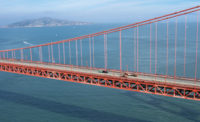A project upgrading San Francisco’s Golden Gate Bridge is nearing a key milestone as installation of a suicide deterrent net is about 90% complete. But even as the contractors expect to complete the net within weeks, the overall project remains years behind schedule and is the subject of an ongoing court case.
The Golden Gate Bridge Physical Suicide Deterrent and Wind Retrofit project includes building a physical suicide deterrent net 20 ft below and 20 ft out from both sides of the 1.7-mile bridge. The net is made of 385,000 sq ft of marine-grade stainless steel stretched across 555 tons of steel supports. The project’s scope also includes construction of wind retrofits, plus the removal and replacement of a “traveler” system under the bridge used for maintenance access.
Paolo Cosulich-Schwartz, a spokesperson for the project owner, the Golden Gate Bridge Highway & Transportation District, says the district expects the net will be complete around the end of the year.
Shimmick/Danny’s Joint Venture, the prime contractor on the project consisting of Shimmick Construction Co. Inc. and Danny’s Construction Co. LLC, won a $142-million contract for the work in 2017, beating out one other bidder.
“We have never had a more important project and we are honored to have had the opportunity to work on the Golden Gate Bridge,” said Steve Richards, CEO of Shimmick, in a statement.
Setbacks and Dispute
Work was originally scheduled to completed in early 2021, but the project faced setbacks—the exact nature of those setbacks is part of the legal dispute—and the latest estimate shared by the team places its completion in 2026.
In a court filing last year, Shimmick/Danny’s said it expected the project would cost $398 million because of delays and overruns it alleged the bridge district caused but was refusing to pay for. The contractor said information about deterioration impacting the traveler system portion of the project was concealed during the bidding process. It also said that the bridge district required an “unnecessary” and more expensive scaffolding standard and that the bridge district was slow in obtaining a Buy America Act waiver for material needed for the traveler system that was not available from a domestic supplier.
In a cross complaint the bridge district filed in October, it alleged the joint venture submitted a lowball bid because Shimmick’s then-owners wanted to add the project to the company’s portfolio of projects in order to attract buyers. It said the contractors never intended to complete the project on time and that they did not fully mobilize for more than two years after receiving the notice to proceed.
Shimmick’s ownership has changed hands several times since it signed the contract. AECOM purchased the company first, then sold it to an investment firm in 2021. Last month, Shimmick went public with an initial stock offering.
The bridge district says subcontracts were executed late, the baseline schedule was developed late, field measurements were taken late, work plans “were persistently incomplete and of poor quality,” the team changed traveler designers, fabricators and subcontractors and that temporary scaffolds were poorly designed.
The contractors “planned to profit through unsubstantiated demands made through the claims process,” the bridge district alleged in its cross-complaint. It accused the contractors of breach of contract, fraudulent inducement, negligent misrepresentation and other wrongdoing.
A trial date is set for next June before Judge Andrew Cheng in a state court in San Francisco. Richards said the contractors did not let the litigation, “or the fact that we haven’t been paid everything we are owed,” prevent the work from continuing.
“Our dispute is with the district,” he said. “The people of California should not be deprived of the safety netting because of the district’s behavior.”
The net may already be having a positive impact, even ahead of its completion. There were 135 Golden Gate Bridge suicides and interventions from the start of the year through October, according to the Bridge Rail Foundation, a nonprofit that has advocated for the net and other means of preventing suicides. That number is down compared to previous years tracked by the group: 153 suicides and interventions through the same period last year, 191 in 2021, 179 in 2020 and 168 in 2019.
If you or someone you know is struggling or in crisis, help is available. Call or text 988 or chat at 988lifeline.org.




Post a comment to this article
Report Abusive Comment